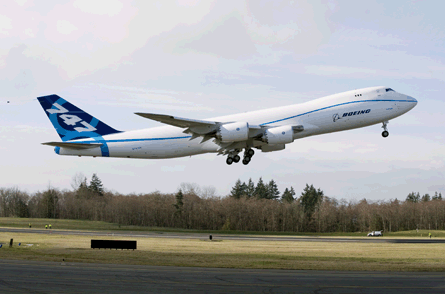Boeing's 747-8F has the market at the top of the new-build freighter market to itself while Airbus's A380F programme is in limbo, but the new Jumbo's early life faces a stiff headwind as the world's cargo market has taken a nearly unprecedented hit as the global economy has sharply contracted.
The global freight market, which includes container ship and air cargo, contracted 15% in 2008-09, and 7% in 2007-08, resulting in a full 14% drop from its peak in 2007, says Tom Crabtree, Boeing regional director of airline revenue analysis for cargo marketing.
The International Air Transport Association says that the air cargo industry alone is down 10.1% for 2009, after a 4% drop in 2008.
 |
|---|
© Boeing |
By comparison, Crabtree adds that relative to container shipping, which is expected to report losses of $20 billion in 2009, air freight has fared better as the total passenger and air freight industry lost $11 billion last year, according to IATA.
Crabtree does not sugarcoat the current state of the market. The only period worse than the drop between 2007 and 2009 was the 22% decline in global freight recorded between 1930 and 1934 during the Great Depression.
Boeing absorbed $360 million of a $1 billion charge against the 747 programme as a result of declining demand for cargo aircraft and was forced into holding production rates at 1.5 aircraft a month, indefinitely deferring a planned ramp-up.
Crabtree estimates that it will take about three years to return to 2007 levels and Boeing's 20-year forecast calls for 830 widebody freighters to be delivered during that period, including 490 factory-built cargo aircraft from large twinjets like the 767/A330 to the 747/A380.
Road to 747-8F first flight crossed many hurdles The 747-8F's first flight comes more than a year after the December 2008 date originally planned by Boeing. Closure of the 747-400 line, resource starvation, a machinists' strike and late design changes added up to a delay of just over a year. The latest Jumbo Jet iteration, which was launched in November 2005, features a new super-critical wing, expanded use of advanced composites, new General Electric GEnx engines, an updated flightdeck, and lateral fly-by-wire controls of its ailerons and spoilers as well as 16% more cargo volume over its predecessor, the 747-400ERF. It has a 442,000kg (975,000lb) maximum take-off weight and a range of 8,140km (4,390nm). |
Source: Flight International



















